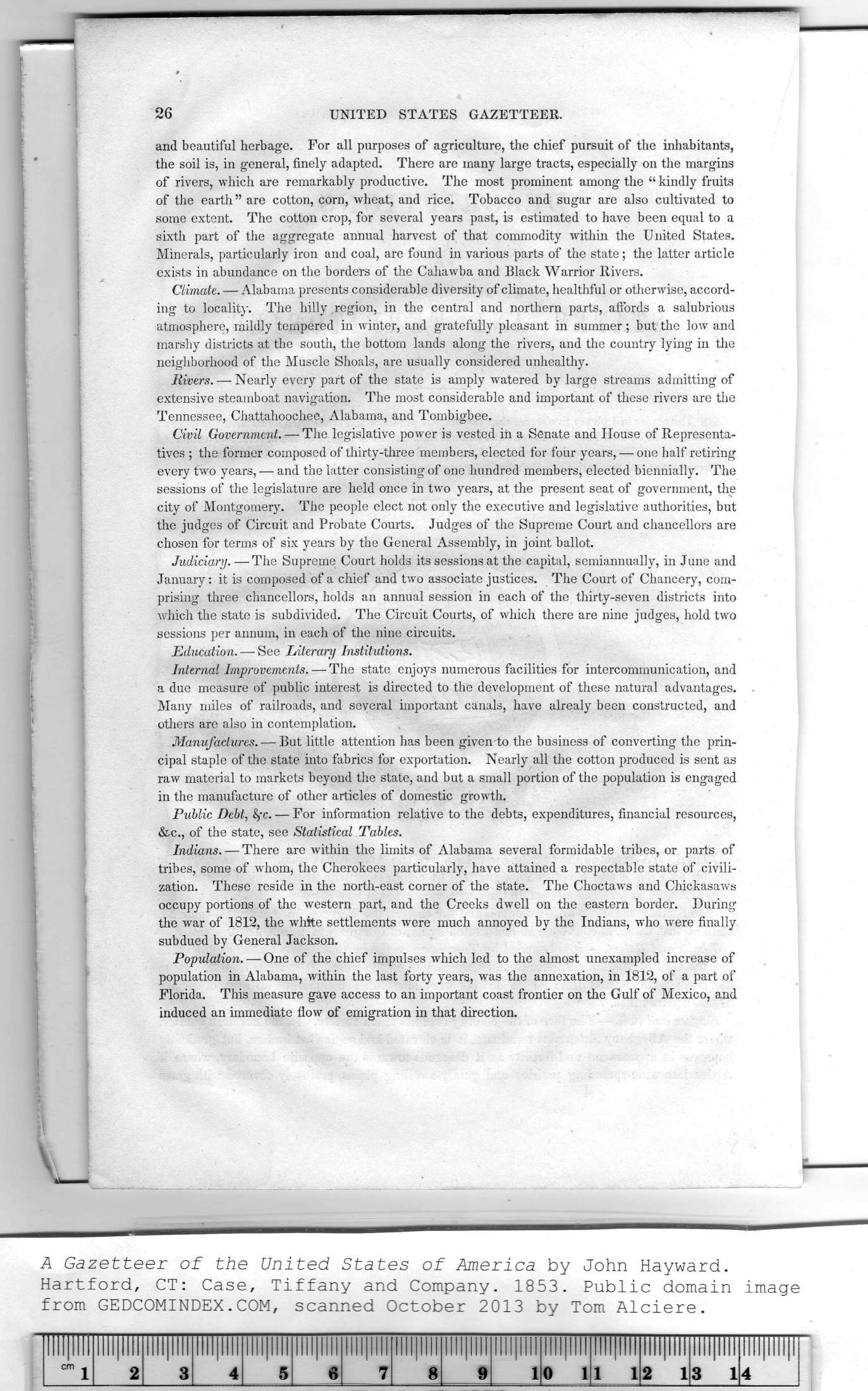|
|
Note: Ctrl and + increases the font size of the text below, Ctrl and - decreases it, and Ctrl and 0 resets it to default size.
26 UNITED STATES GAZETTEER.
and beautiful herbage. For all purposes of agriculture, the chief pursuit of the inhabitants,
the soil is, in general, finely adapted. There are many large tracts, especially on the margins
of rivers, which are remarkably productive. The most prominent among the “ kindly fruits
of the earth " are cotton, corn, wheat, and rice. Tobacco and sugar are also cultivated to
some extent. The cotton crop, for several years past, is estimated to have been equal to a
sixth part of the aggregate annual harvest of that commodity within the United States.
Minerals, particularly iron and coal, are found in various parts of the state; the latter article
exists in abundance on the borders of the Cahawba and Black Warrior Rivers.
Climate. — Alabama presents considerable diversity of climate, healthful or otherwise, accord-
ing to locality. The hilly region, in the central and northern parts, affords a salubrious
atmosphere, mildly tempered in winter, and gratefully pleasant in summer; but the low and
marshy districts at the south, the bottom lands along the rivers, and the country lying in the
neighborhood of the Muscle Shoals, are usually considered unhealthy.
Rivers. — Nearly every part of the state is amply watered by large streams admitting of
extensive steamboat navigation. The most considerable and important of these rivers are the
Tennessee, Chattahoochee, Alabama, and Tombigbee.
Civil Government. — The legislative power is vested in a Senate and House of Representa-
tives ; the former composed of thirty-three members, elected for four years, — one half retiring
every two years, — and the latter consisting of one hundred members, elected biennially. The
sessions of the legislature are held once in two years, at the present seat of government, the
city of Montgomery. The people elect not only the executive and legislative authorities, but
the judges of Circuit and Probate Courts. Judges of the Supreme Court and chancellors are
chosen for terms of six years by the General Assembly, in joint ballot.
Judiciary. — The Supreme Court holds its sessions at the capital, semiannually, in June and
January: it is composed of a chief and two associate justices. The Court of Chancery, com-
prising three chancellors, holds an annual session in each of the thirty-seven districts into
which the state is subdivided. The Circuit Courts, of which there are nine judges, hold two
sessions per annum, in each of the nine circuits.
Education. — See Literary Institutions.
Internal Improvements. — The state enjoys numerous facilities for intercommunication, and
a due measure of public interest is directed to the development of these natural advantages.
Many miles of railroads, and several important canals, have alrealy been constructed, and
others are also in contemplation.
Manufactures. — But little attention has been given to the business of converting the prin-
cipal staple of the state into fabrics for exportation. Nearly all the cotton produced is sent as
raw material to markets beyond the state, and but a small portion of the population is engaged
in the manufacture of other articles of domestic growth.
Public Debt, fyc. — For information relative to the debts, expenditures, financial resources,
&c., of the state, see Statistical Tables.
Indians. — There are within the limits of Alabama several formidable tribes, or parts of
tribes, some of whom, the Cherokees particularly, have attained a respectable state of civili-
zation. These reside in the north-east corner of the state. The Choctaws and Chickasaws
occupy portions of the western part, and the Creeks dwell on the eastern border. During
the war of 1812, the white settlements were much annoyed by the Indians, who were finally
subdued by General Jackson.
Population. — One of the chief impulses which led to the almost unexampled increase of
population in Alabama, within the last forty years, was the annexation, in 1812, of a part of
Florida. This measure gave access to an important coast frontier on the Gulf of Mexico, and
induced an immediate flow of emigration in that direction.
A Gazetteer of the United States of America by John Hayward.
Hartford, CT: Case, Tiffany and Company. 1853. Public domain
|
